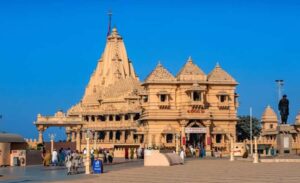History of Tungnath Temple
Tungnath Temple, situated in the Garhwal region of Uttarakhand, India, stands as a testament to the rich cultural and religious heritage of the Himalayan region. Nestled at an altitude of 3,680 meters (12,073 feet), it is renowned as the highest Shiva temple in the world. The history of Tungnath Temple is a fascinating tale that spans centuries, reflecting the spiritual significance and architectural marvels of the region.

Ancient Roots
The origins of Tungnath Temple can be traced back to ancient Hindu mythology. According to popular belief, it is one of the Panch Kedar, a group of five sacred temples dedicated to Lord Shiva. The legend associated with Tungnath dates back to the Mahabharata, one of the great epics of Hindu mythology. It is said that after the Kurukshetra War, the Pandavas sought the blessings of Lord Shiva to absolve themselves of the sins committed during the war.
The Pandavas, led by Yudhishthira, embarked on a journey to find Lord Shiva. However, Lord Shiva, unwilling to forgive them immediately, disguised himself as a bull and hid in the Garhwal region. The Pandavas, determined to find Shiva, followed the bull, and when they reached Tungnath, the bull’s body parts reappeared. The hump is believed to have emerged at Kedarnath, the arms at Tungnath, the face at Rudranath, the navel at Madhyamaheshwar, and the hair at Kalpeshwar. Tungnath thus became the sacred spot where the arms of Lord Shiva were discovered, leading to the construction of the temple.
Architectural Marvels
The architecture of Tungnath Temple showcases the ancient skills and craftsmanship of the region. Constructed in the North Indian style, the temple is made of local gray slates, with intricate carvings and designs adorning its walls. The sanctum sanctorum houses the idol of Lord Shiva, and the temple complex includes a mandapa (hall) for devotees to gather during rituals.
The unique feature of Tungnath is its continuous worship, making it one of the oldest temples where rituals have been performed without a break. The temple underwent renovations and expansions over the centuries, with various rulers and devotees contributing to its maintenance and beautification.
Cultural and Historical Significance
Tungnath Temple holds immense cultural and historical significance in the religious landscape of India. The Panch Kedar pilgrimage, including Tungnath, attracts thousands of devotees and trekkers annually. Pilgrims believe that undertaking this arduous journey and seeking the blessings of Lord Shiva at each of the Panch Kedar sites will cleanse them of their sins and bestow divine grace.
The temple has witnessed the ebb and flow of various dynasties that ruled the region, including the Katyuri and Garhwal kingdoms. These rulers not only patronized the temple but also contributed to its upkeep and embellishment. The inscriptions and sculptures found in and around the temple complex offer glimpses into the historical evolution of Tungnath.
Challenges and Conservation
Despite its remote location and harsh weather conditions, Tungnath Temple has weathered the tests of time. However, it has faced challenges, including natural disasters such as earthquakes and heavy snowfall. The region’s susceptibility to landslides has also posed threats to the temple’s structural integrity.
To counter these challenges, various governmental and non-governmental initiatives have been undertaken to conserve and protect Tungnath. Conservation efforts focus on both the temple’s structural preservation and the surrounding ecological balance. The delicate balance between promoting tourism and safeguarding the temple’s sanctity has been a constant concern.
Pilgrimage and Trekking
The journey to Tungnath is not just a religious pilgrimage but also a trekking adventure that takes devotees through picturesque landscapes and alpine meadows. The trek starts from Chopta, a quaint village at a lower altitude, and winds its way up through dense forests and snow-clad slopes.
The trek to Tungnath is not only a physical challenge but also a spiritual experience. Pilgrims and trekkers encounter breathtaking vistas of the Garhwal Himalayas, including the majestic peaks of Nanda Devi, Trishul, and Chaukhamba. The trekking route serves as a metaphorical journey of self-discovery and devotion, mirroring the Pandavas’ quest for redemption in Hindu mythology.
Conclusion
Tungnath Temple stands as a beacon of spirituality and architectural excellence in the heart of the Himalayas. Its rich history, intertwined with Hindu mythology, speaks to the enduring cultural and religious traditions of the region. The temple’s lofty location, challenging trek, and the surrounding natural beauty make it a unique destination that attracts not only pilgrims but also adventure enthusiasts.
As Tungnath continues to be a living testament to the spiritual fabric of India, efforts to preserve its heritage and ecology must be redoubled. The temple’s timeless significance, both as a religious site and a symbol of human perseverance, ensures that it will continue to inspire awe and reverence for generations to come.
Also Read







